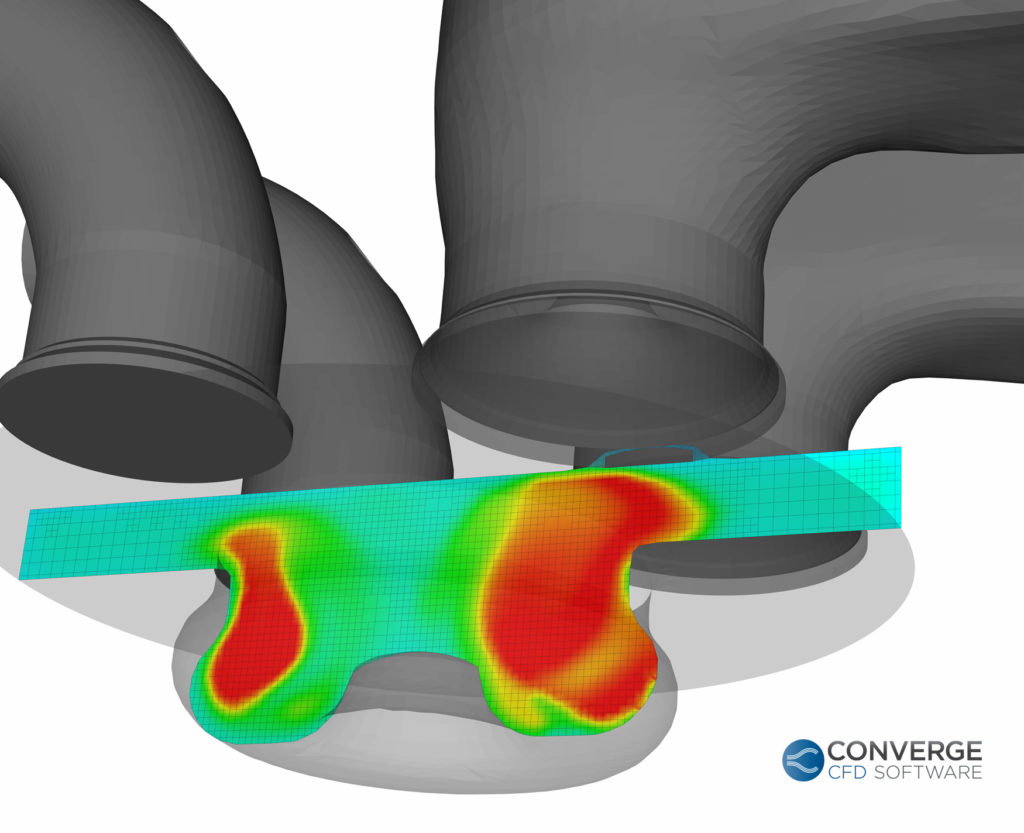
Author:
Elizabeth Favreau
Marketing Writing Team Lead
As I’ve started to cook more, I’ve learned the true value of multipurpose kitchen utensils and appliances. Especially living in an apartment with limited kitchen space, the fewer tools I need to make delicious meals, the better. A rice cooker that doubles as a slow cooker? Great. A blender that’s also a food processor? Sign me up. Not only do these tools prove to be more useful, but they’re also more economical.
The same principle applies beyond kitchen appliances. CONVERGE CFD software is well known for its flow solver, autonomous meshing, and fully coupled chemistry solver, but did you know that it also features an extensive suite of chemistry tools, with even more coming in version 3.0? Whether you need to speed up your abnormal combustion simulations, create and validate new chemical mechanisms, expedite your design process with 0D or 1D modeling, or compare your chemical kinetics experiments with simulated results, CONVERGE chemistry tools have you covered. The many capabilities of CONVERGE translate to a broadly applicable piece of software for CFD and beyond.
Zero-Dimensional Simulations
CONVERGE 3.0 expands on the previous versions’ 0D simulation capabilities with a host of new tools and reactors that are useful across a wide range of applications. If you’re running diesel engine simulations, you can take advantage of CONVERGE’s autoignition utility to quickly generate ignition delay data for different combinations of temperature, pressure, and equivalence ratio. Furthermore, you can couple the autoignition utility with 0D sensitivity analysis to determine which reactions and species are important for ignition or to determine the importance of various reactions in forming a given species.

The variable volume tool in CONVERGE 3.0 is a closed homogeneous reactor that can simulate a rapid compression machine (RCM). RCMs are ideal for chemical kinetics studies, especially for understanding autoignition chemistry as a function of temperature, pressure, and fuel/oxygen ratio.
Another new reactor model is the 0D engine tool, which can provide information on autoignition and engine knock. HCCI engines operate by compressing well-mixed fuel and oxidizer to the point of autoignition, and so you can use the 0D engine tool to gain valuable insight into your HCCI engine.
For other applications, look toward the well-stirred reactor (WSR) model coming in 3.0. The WSR assumes a high rate of mixing so that the output composition is identical to the composition inside the reactor. WSRs are thus useful for studying highly mixed IC engines, highly turbulent portions of non-premixed combustors, and ignition and extinction limits on residence time such as lean blow-out in gas turbines.
In addition to the new 0D reactor models, CONVERGE 3.0 will also feature new 0D tools. The chemical equilibrium (CEQ) solver calculates the concentration of species at equilibrium. The CEQ solver in CONVERGE, unlike many equilibrium solvers, is guaranteed to converge for any combination of gas species. The RON/MON estimator finds the research octane number (RON) and motor octane number (MON) for a fuel by finding the critical compression ratio (CCR) at which autoignition occurs and correlates this with the CCR of PRF fuel composition using the LLNL Gasoline Mechanism.
One-Dimensional Simulations
For 1D simulations, CONVERGE contains the 1D laminar premixed flame tool, which calculates the flamespeed of a combustion reaction using a freely propagating flame. You can use this tool to ensure your mechanisms yield reasonable flamespeeds for specific conditions and to generate laminar flamespeed tables that are needed for some combustion models, such as G-Equation, ECFM, and TFM. In CONVERGE 3.0, this solver has seen significant improvement in parallelization and scalability, as shown in Fig. 1. You can additionally perform 1D sensitivity analysis to determine how sensitive the flamespeed is to the various reactions and species in your mechanism.


CONVERGE 3.0 also includes a new 1D reactor model: the plug flow reactor (PFR). PFRs can be used to predict chemical kinetics behavior in continuous, flowing systems with cylindrical geometry. PFRs have commonly been applied to study both homogeneous and heterogeneous reactions, continuous production, and fast or high-temperature reactions.
Chemistry Tools
Zero- and one-dimensional simulation tools aren’t all CONVERGE has to offer. CONVERGE also features a number of tools for optimizing reaction mechanisms and interpreting your chemical kinetics simulation results.
Detailed chemistry calculations can be computationally expensive, but you can decrease computational time by reducing your chemical mechanism. CONVERGE’s mechanism reduction utility eliminates species and reactions that have the least effect on the simulation results, so you can reduce computational expense while maintaining your desired level of accuracy. In previous versions of CONVERGE, mechanism reduction was only available to target ignition delay. In CONVERGE 3.0, you can also target flamespeed, so you can ensure that your reduced mechanism maintains a similar flamespeed as the parent mechanism.
CONVERGE additionally offers a mechanism tuning utility to optimize reaction mechanisms. This tool prepares input files for running a genetic algorithm optimization using CONVERGE’s CONGO utility, so you can tune your mechanism to meet specified performance targets.
If you’re developing multi-component surrogate mechanisms, or you need to add additional pathways or NOx chemistry to a fuel mechanism, the mechanism merge tool is the one for you. This tool combines two reaction mechanisms into one and resolves any duplicate species or reactions along the way.
CONVERGE 3.0 will feature new table generation and visualization tools. With the tabulated kinetics of ignition (TKI) and tabulated laminar flamespeed (TLF) tools, you can generate ignition or flamespeed tables that are needed for certain combustion models. To visualize your results, you can run a CONVERGE utility to prepare your tables for visualization in Tecplot for CONVERGE or other visualization software.
CONVERGE’s suite of chemistry tools is just one of the components that make CONVERGE a robust, multipurpose solver. And just as multipurpose kitchen appliances have more uses during meal prep, CONVERGE’s chemistry capabilities mean our software has a broad scope of applications for not just CFD—but for all of your chemical kinetics simulation needs. Interested in learning more about CONVERGE or CONVERGE’s chemistry tools? Contact us today!


